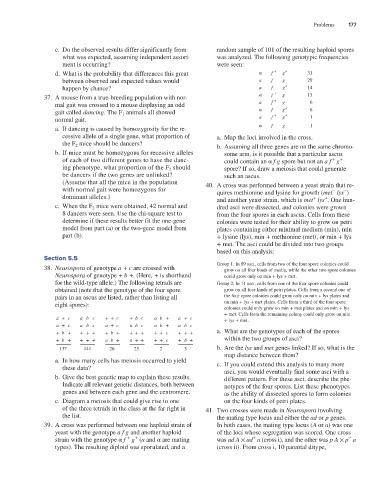Page 185 - Genetics_From_Genes_to_Genomes_6th_FULL_Part1
P. 185
Problems 177
c. Do the observed results differ significantly from random sample of 101 of the resulting haploid spores
what was expected, assuming independent assort- was analyzed. The following genotypic frequencies
ment is occurring? were seen:
d. What is the probability that differences this great α f + g + 31
between observed and expected values would a f g 29
happen by chance? a f g + 14
37. A mouse from a true-breeding population with nor- α f + g 13
+
mal gait was crossed to a mouse displaying an odd a f g + 6
gait called dancing. The F 1 animals all showed α f + g + 6
normal gait. a f g 1
a. If dancing is caused by homozygosity for the re- α f g 1
cessive allele of a single gene, what proportion of a. Map the loci involved in the cross.
the F 2 mice should be dancers? b. Assuming all three genes are on the same chromo-
b. If mice must be homozygous for recessive alleles some arm, is it possible that a particular ascus
of each of two different genes to have the danc- could contain an α f g spore but not an a f g
+
+
ing phenotype, what proportion of the F 2 should spore? If so, draw a meiosis that could generate
be dancers if the two genes are unlinked? such an ascus.
(Assume that all the mice in the population 40. A cross was performed between a yeast strain that re-
with normal gait were homozygous for quires methionine and lysine for growth (met lys )
−
−
dominant alleles.) and another yeast strain, which is met lys . One hun-
+
+
c. When the F 2 mice were obtained, 42 normal and dred asci were dissected, and colonies were grown
8 dancers were seen. Use the chi-square test to from the four spores in each ascus. Cells from these
determine if these results better fit the one-gene colonies were tested for their ability to grow on petri
model from part (a) or the two-gene model from plates containing either minimal medium (min), min
part (b). + lysine (lys), min + methionine (met), or min + lys
+ met. The asci could be divided into two groups
based on this analysis:
Section 5.5
Group 1: In 89 asci, cells from two of the four spore colonies could
38. Neurospora of genotype a + c are crossed with grow on all four kinds of media, while the other two spore colonies
Neurospora of genotype + b +. (Here, + is shorthand could grow only on min + lys + met.
for the wild-type allele.) The following tetrads are Group 2: In 11 asci, cells from one of the four spore colonies could
obtained (note that the genotype of the four spore grow on all four kinds of petri plates. Cells from a second one of
pairs in an ascus are listed, rather than listing all the four spore colonies could grow only on min + lys plates and
eight spores): on min + lys + met plates. Cells from a third of the four spore
colonies could only grow on min + met plates and on min + lys
+ met. Cells from the remaining colony could only grow on min
a + c a b c + + c + b c a b + a + c + lys + met.
a + c a b c a + c a b c a b + a b c
+ b + + + + + b + + + + + + c + + + a. What are the genotypes of each of the spores
+ b + + + + a b + a + + + + c + b + within the two groups of asci?
137 141 26 25 2 3 b. Are the lys and met genes linked? If so, what is the
map distance between them?
a. In how many cells has meiosis occurred to yield c. If you could extend this analysis to many more
these data? asci, you would eventually find some asci with a
b. Give the best genetic map to explain these results. different pattern. For these asci, describe the phe-
Indicate all relevant genetic distances, both between notypes of the four spores. List these phenotypes
genes and between each gene and the centromere. as the ability of dissected spores to form colonies
c. Diagram a meiosis that could give rise to one on the four kinds of petri plates.
of the three tetrads in the class at the far right in 41. Two crosses were made in Neurospora involving
the list. the mating type locus and either the ad or p genes.
39. A cross was performed between one haploid strain of In both cases, the mating type locus (A or a) was one
yeast with the genotype a f g and another haploid of the loci whose segregation was scored. One cross
+
+
+
+
strain with the genotype α f g (a and α are mating was ad A × ad a (cross i), and the other was p A × p a
types). The resulting diploid was sporulated, and a (cross ii). From cross i, 10 parental ditype,

